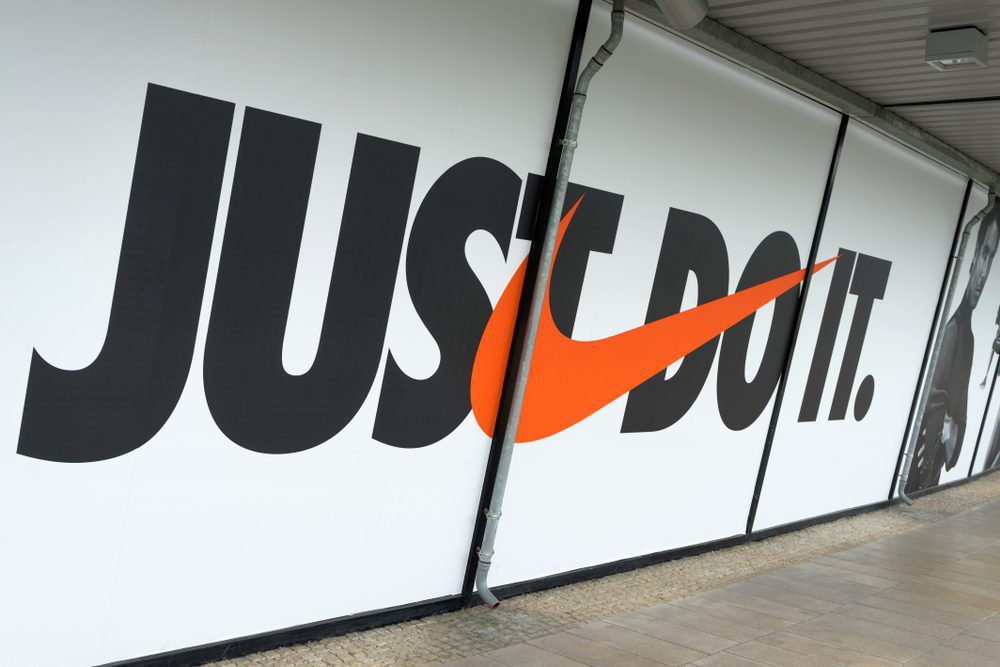The swoosh that once symbolized unstoppable athletic dominance now faces its greatest challenge in decades. Nike, the sportswear behemoth that built an empire on the backs of legendary athletes and cultural icons, finds itself wrestling with financial pressures that threaten to reshape the entire athletic footwear landscape. The company’s recent earnings revelation has sent shockwaves through the industry, as executives disclosed a staggering financial burden that could fundamentally alter how Americans shop for athletic gear.
The magnitude of Nike’s current predicament extends far beyond typical business fluctuations. This isn’t simply about quarterly earnings or seasonal adjustments – it represents a perfect storm of economic policies, shifting consumer behaviors, and intense market competition that has cornered one of America’s most recognizable brands. The implications stretch from corporate boardrooms to neighborhood basketball courts, affecting everyone from professional athletes to parents shopping for their children’s back-to-school needs.
Unprecedented financial pressure rocks Nike’s foundation
The numbers paint a stark picture of Nike’s immediate future. Chief Financial Officer Matthew Friend delivered sobering news during the company’s latest earnings call, revealing that new tariff policies will burden the company with approximately $1 billion in additional costs throughout the current fiscal year. This astronomical figure represents more than just a line item on financial statements – it signals a fundamental shift in how Nike must operate in an increasingly complex global marketplace.
The timing of these financial pressures couldn’t be worse for Nike. The company has been working tirelessly to recover from a challenging period marked by declining sales and increased competition from both established rivals and emerging brands. The additional billion-dollar burden threatens to derail recovery efforts just as the company began showing signs of stabilization.
This financial challenge forces Nike into an uncomfortable position where every decision carries significant risk. The company must balance maintaining profitability with preserving market share, all while navigating an economic environment that has made consumers increasingly price-conscious. The pressure extends beyond immediate financial concerns, potentially affecting Nike’s ability to invest in innovation, marketing, and athlete partnerships that have historically driven brand loyalty.
Strategic response reveals company’s desperate measures
Faced with unprecedented cost pressures, Nike has developed what executives describe as a “surgical price hike” strategy, carefully targeting specific products and timing increases to minimize consumer backlash. This approach demonstrates the company’s recognition that broad price increases could drive customers to competitors, particularly during economically challenging times when families are scrutinizing every purchase.
The timing of these price adjustments coincides with the back-to-school shopping season, traditionally one of Nike’s strongest revenue periods. This strategic decision reflects the company’s belief that parents will prioritize quality athletic gear for their children’s school and sports activities, even at higher price points. However, this gamble could backfire if families choose to shop at outlet stores or consider alternative brands that offer comparable quality at lower prices.
Nike’s pricing strategy reveals the delicate balance the company must maintain between protecting profit margins and preserving customer relationships. The “surgical” approach suggests careful market research and consumer analysis, but it also indicates the company’s awareness that aggressive price increases could permanently damage brand perception among price-sensitive consumers.
Manufacturing shift signals major operational overhaul
Beyond pricing adjustments, Nike is implementing significant changes to its global manufacturing strategy. The company currently produces 16 percent of its inventory in China, but plans call for reducing this figure to single digits by the end of the next fiscal year. This dramatic shift represents more than a simple cost-cutting measure – it signals Nike’s recognition that diversified manufacturing is essential for long-term stability.
The move away from Chinese manufacturing reflects broader trends in global commerce, as companies seek to reduce dependency on single-country production. For Nike, this transition involves identifying alternative manufacturing locations, establishing new supplier relationships, and potentially accepting higher production costs in exchange for greater operational flexibility.
This manufacturing transition carries significant implications for product availability and pricing. Establishing new production facilities and training new manufacturing partners requires substantial time and investment. During this transition period, Nike may face supply chain disruptions that could affect product launches and seasonal inventory management.
Consumer behavior challenges Nike’s premium positioning
The current economic environment has fundamentally altered how consumers approach athletic footwear purchases. Families facing stagnant wages and rising living costs are increasingly questioning whether premium athletic gear justifies its higher price points. This shift in consumer mindset poses a direct challenge to Nike’s strategy of maintaining premium pricing while competitors offer comparable alternatives at lower costs.
The impact on families with children involved in sports activities could be particularly significant. Nike has long dominated the youth athletic market, but parents may now consider whether expensive Nike gear provides sufficient value compared to more affordable options. This trend could have long-term implications for brand loyalty, as children who grow up wearing alternative brands may continue those preferences into adulthood.
Outlet malls and discount retailers have become increasingly attractive to cost-conscious consumers, offering previous-season Nike products at significantly reduced prices. This trend undermines Nike’s full-price retail strategy and creates internal competition between current and past product lines. The company must navigate this challenge while maintaining relationships with full-price retail partners.
Recovery signs offer cautious optimism amid challenges
Despite facing significant headwinds, Nike has demonstrated some encouraging signs of stabilization. The company’s sales decline moderated from 12 percent last year to 7 percent in the current reporting period, suggesting that recovery efforts may be gaining traction. This improvement, while modest, provides hope that Nike’s strategic initiatives are beginning to yield positive results.
CEO Elliott Hill expressed measured optimism during recent earnings discussions, emphasizing that the company’s repositioning efforts are starting to show results. This executive confidence suggests that internal metrics and market research indicate improving trends that may not yet be fully reflected in public financial reports.
The gradual improvement in sales performance indicates that Nike’s brand strength remains intact despite current challenges. Consumer loyalty to the Nike brand, built over decades of successful marketing and product innovation, provides a foundation for recovery efforts. This brand equity becomes increasingly valuable as Nike navigates current challenges and positions itself for future growth.
Air Jordan 40 launch represents crucial brand revival attempt
Nike’s introduction of the Air Jordan 40 represents more than a routine product launch – it symbolizes the company’s commitment to revitalizing its most iconic brand. The new model attempts to capture the essence of original Jordan designs that revolutionized basketball footwear while incorporating modern performance technologies that today’s athletes demand.
The Air Jordan 40’s design philosophy reflects Nike’s understanding that successful products must balance nostalgia with innovation. By drawing inspiration from Michael Jordan’s playing era while incorporating contemporary materials and construction techniques, Nike hopes to appeal to both longtime brand loyalists and new customers discovering Jordan products for the first time.
The success of the Air Jordan 40 could significantly influence Nike’s overall recovery trajectory. Jordan brand products typically command premium prices and generate substantial profit margins, making them crucial for offsetting increased costs from tariffs and manufacturing changes. Strong sales performance for this launch could provide the financial breathing room Nike needs to implement other strategic initiatives.
Market dynamics reshape athletic footwear landscape
The challenges facing Nike reflect broader changes in the athletic footwear industry, where established hierarchies are being disrupted by new brands, changing consumer preferences, and evolving retail models. Traditional brand loyalty is being tested as consumers become more willing to experiment with alternative options that offer better value propositions.
Social media influence has transformed how consumers discover and evaluate athletic footwear options. Younger consumers, in particular, are more likely to consider brands based on social media presence, influencer endorsements, and peer recommendations rather than traditional marketing campaigns. This shift requires Nike to adapt its marketing strategies while maintaining its core brand identity.
The rise of direct-to-consumer sales channels has also changed competitive dynamics. Smaller brands can now reach consumers directly without requiring extensive retail partnerships, creating new competition for market share. Nike must balance its traditional retail relationships with direct-to-consumer initiatives while competing against more agile competitors.
Future outlook depends on strategic execution
Nike’s path forward requires careful execution of multiple strategic initiatives simultaneously. The company must successfully implement price increases without alienating customers, transition manufacturing operations without disrupting supply chains, and launch new products that restore brand excitement. Each of these challenges is significant individually, and their combined execution will determine Nike’s future market position.
The company’s ability to weather current challenges will largely depend on whether consumers continue to value the Nike brand enough to accept higher prices. If the brand’s cultural significance and product quality justify premium pricing, Nike may successfully navigate current difficulties. However, if consumers migrate to alternative brands offering similar quality at lower prices, Nike’s market position could be permanently weakened.
The next fiscal year will be crucial for Nike’s long-term prospects. The company’s performance during this period will indicate whether current strategic initiatives are sufficient to address fundamental challenges or if more dramatic changes are required. Success will be measured not just in financial metrics but in brand perception, market share retention, and customer loyalty preservation.
Nike‘s current situation represents a defining moment for one of America’s most iconic brands. The company’s response to these challenges will determine whether it emerges stronger and more resilient or whether it must accept a diminished role in the athletic footwear market it once dominated.












